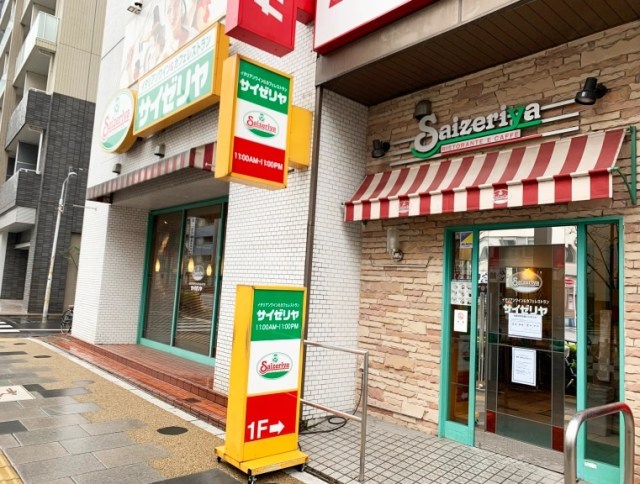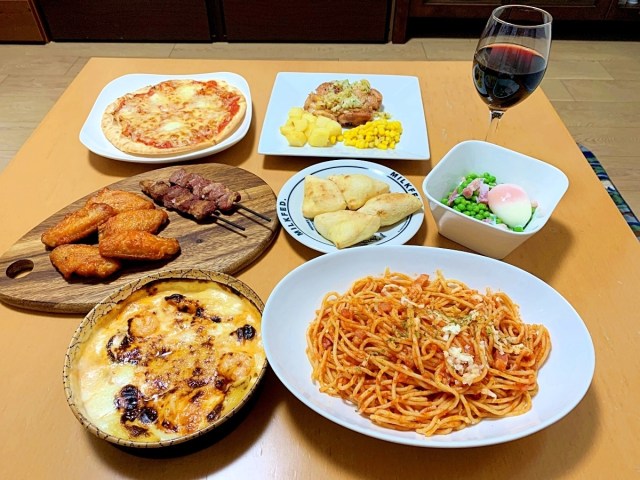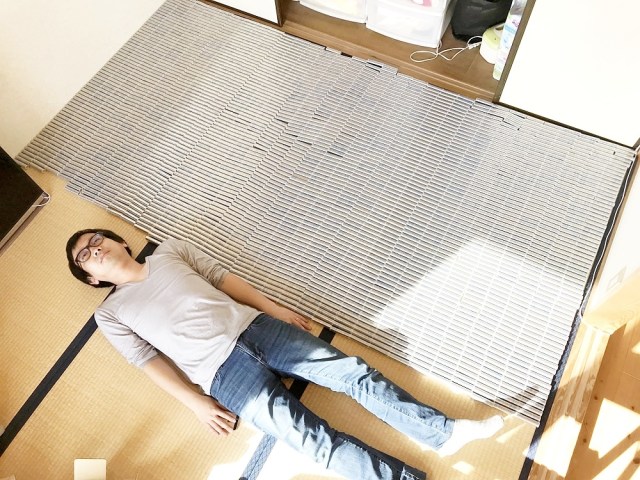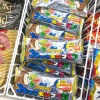
Saizeriya’s price bump isn’t an economic decision, it’s a health one.
For decades, restaurant chain Saizeriya has been an oasis for budget-conscious diners in Japan. Yes, the name on the door, “Saizeriya Ristorante e Caffé,” sounds fancy, but Saizeriya offers some of the cheapest sit-down meals in all of Japan, and is often even more affordable than fast food joints with its doria (baked rice and cheese dishes) for just 299 yen (US$2.80) and pizzas and pasta for 399 yen.
So those whose first instinct is to check their wallet when they hear their stomach growling, such as students, part-timers, and Internet writers, were holding their breath when it was announced last month that Saizeriya would be raising its prices on 140 different menu items. They got to breathe a sigh of relief, though, when they found out the increase for those items, which went into effect at the start of July, was just one yen (less than one U.S. cent).
▼ One of our previous Saizeriya feasts
So why the miniscule price bump? For the same reason a lot of things are happening these days: the coronavirus.
Because Saizeriya lists its prices as after tax, the restaurant doesn’t have a service charge, and there’s no tipping in Japan, if you order a 399-yen pizza Margherita, that’s exactly what you’re paying. Rather than count out 399 yen in change, though, most customers will just use four 100-yen coins, which means they’ll be getting a one-yen coin back in change. People who’d have been ordering Saizeriya’s 399-yen hamburger steak, 299-yen spaghetti pepperoncino, or 999-yen rib eye steak (the most expensive thing on the menu) faced a similar scenario.
In a time when hand hygiene is of the utmost importance, Saizeriya decided to rethink the effects of its pricing system. Yes, 299 yen is obviously cheaper for customers than 300 yen, and psychologically it makes an item an easier purchase, which helps Sazeriya’s bottom line. But with coins being a potential conduit for all sorts of gross germs, ultimately the chain feels that this probably isn’t the right time to be handing out so much change, and so it decided to bump items with a price ending in 99 up one yen for an even number and fewer coins to put in customers’ hands.
▼ We know all too well what’s it’s like to have too many 100-yen coins.
Extending that logic, Saizeriya has reworked its prices so that all items now have a price ending in either 00 or 50, negating the need to give customers any one, five, or ten-yen coins as change. And while that means higher prices (by as much as 21 yen) for the majority of the menu, there are also a few items that are now cheaper than they were before, such as rice (now 19 yen cheaper), garlic bread, and focaccia (both 11 yen cheaper).
Between the revised prices and greater promotion of cashless payment systems, Saizeriya hopes to reduce the number of coins it gives out as change by 80 percent. And even if some of our favorite items now cost us one yen more, Saizeria is still one of the least expensive places to fill up in Japan, even if you’re actively trying to run up the highest bill you can.
Sources: Toyo Keizai via Hachima Kiko, Saizeriya, Sankei Biz
Photos ©SoraNews24
● Want to hear about SoraNews24’s latest articles as soon as they’re published? Follow us on Facebook and Twitter!



 Super Budget Dining in Japan – What’s the best way to spend 1,000 yen (US$6.70) at Saizeriya?
Super Budget Dining in Japan – What’s the best way to spend 1,000 yen (US$6.70) at Saizeriya? Our Japanese writers were taken to a mystery destination for their year-end party
Our Japanese writers were taken to a mystery destination for their year-end party Japan’s top 10 best-value family restaurants, as chosen by diners
Japan’s top 10 best-value family restaurants, as chosen by diners Japanese Twitter breaks down the perfect spot for a first date, and it’s surprisingly cheap
Japanese Twitter breaks down the perfect spot for a first date, and it’s surprisingly cheap We’re utterly stumped by this kids’ Spot the Difference Puzzle from a Japanese family restaurant
We’re utterly stumped by this kids’ Spot the Difference Puzzle from a Japanese family restaurant McDonald’s new Happy Meals offer up cute and practical Sanrio lifestyle goods
McDonald’s new Happy Meals offer up cute and practical Sanrio lifestyle goods All-you-can-drink Starbucks and amazing views part of Tokyo’s new 170 meter-high sky lounge
All-you-can-drink Starbucks and amazing views part of Tokyo’s new 170 meter-high sky lounge Studio Ghibli glasses cases let anime characters keep an eye on your spectacles
Studio Ghibli glasses cases let anime characters keep an eye on your spectacles More foreign tourists than ever before in history visited Japan last month
More foreign tourists than ever before in history visited Japan last month Beautiful Sailor Moon manhole cover coasters being given out for free by Tokyo tourist center
Beautiful Sailor Moon manhole cover coasters being given out for free by Tokyo tourist center Starbucks reopens at Shibuya Scramble Crossing with new look and design concept
Starbucks reopens at Shibuya Scramble Crossing with new look and design concept Is the new Shinkansen Train Desk ticket worth it?
Is the new Shinkansen Train Desk ticket worth it? Mister Donut ready to make hojicha dreams come true in latest collab with Kyoto tea merchant
Mister Donut ready to make hojicha dreams come true in latest collab with Kyoto tea merchant The oldest tunnel in Japan is believed to be haunted, and strange things happen when we go there
The oldest tunnel in Japan is believed to be haunted, and strange things happen when we go there Kyushu-exclusive Black Mont Blanc goes nationwide in a “Special” way
Kyushu-exclusive Black Mont Blanc goes nationwide in a “Special” way Disney princesses get official manga makeovers for Manga Princess Cafe opening in Tokyo
Disney princesses get official manga makeovers for Manga Princess Cafe opening in Tokyo Beautiful new Final Fantasy T-shirt collection on the way from Uniqlo【Photos】
Beautiful new Final Fantasy T-shirt collection on the way from Uniqlo【Photos】 Foreign English teachers in Japan pick their favorite Japanese-language phrases【Survey】
Foreign English teachers in Japan pick their favorite Japanese-language phrases【Survey】 Japanese convenience store packs a whole bento into an onigiri rice ball
Japanese convenience store packs a whole bento into an onigiri rice ball We try out “Chan Ramen”, an underground type of ramen popular in the ramen community
We try out “Chan Ramen”, an underground type of ramen popular in the ramen community Studio Ghibli releases Kiki’s Delivery Service chocolate cake pouches in Japan
Studio Ghibli releases Kiki’s Delivery Service chocolate cake pouches in Japan Japan’s bone-breaking and record-breaking roller coaster is permanently shutting down
Japan’s bone-breaking and record-breaking roller coaster is permanently shutting down New definition of “Japanese whiskey” goes into effect to prevent fakes from fooling overseas buyers
New definition of “Japanese whiskey” goes into effect to prevent fakes from fooling overseas buyers Our Japanese reporter visits Costco in the U.S., finds super American and very Japanese things
Our Japanese reporter visits Costco in the U.S., finds super American and very Japanese things Studio Ghibli unveils Mother’s Day gift set that captures the love in My Neighbour Totoro
Studio Ghibli unveils Mother’s Day gift set that captures the love in My Neighbour Totoro Foreign passenger shoves conductor on one of the last full runs for Japan’s Thunderbird train
Foreign passenger shoves conductor on one of the last full runs for Japan’s Thunderbird train Domino’s Japan now sells…pizza ears?
Domino’s Japan now sells…pizza ears? New Japanese KitKat flavour stars Sanrio characters, including Hello Kitty
New Japanese KitKat flavour stars Sanrio characters, including Hello Kitty Kyoto creates new for-tourist buses to address overtourism with higher prices, faster rides
Kyoto creates new for-tourist buses to address overtourism with higher prices, faster rides Sales of Japan’s most convenient train ticket/shopping payment cards suspended indefinitely
Sales of Japan’s most convenient train ticket/shopping payment cards suspended indefinitely Sold-out Studio Ghibli desktop humidifiers are back so Totoro can help you through the dry season
Sold-out Studio Ghibli desktop humidifiers are back so Totoro can help you through the dry season Japanese government to make first change to romanization spelling rules since the 1950s
Japanese government to make first change to romanization spelling rules since the 1950s Ghibli founders Toshio Suzuki and Hayao Miyazaki contribute to Japanese whisky Totoro label design
Ghibli founders Toshio Suzuki and Hayao Miyazaki contribute to Japanese whisky Totoro label design Doraemon found buried at sea as scene from 1993 anime becomes real life【Photos】
Doraemon found buried at sea as scene from 1993 anime becomes real life【Photos】 Tokyo’s most famous Starbucks is closed
Tokyo’s most famous Starbucks is closed One Piece characters’ nationalities revealed, but fans have mixed opinions
One Piece characters’ nationalities revealed, but fans have mixed opinions We asked a Uniqlo employee what four things we should buy and their suggestions didn’t disappoint
We asked a Uniqlo employee what four things we should buy and their suggestions didn’t disappoint Princesses, fruits, and blacksmiths: Study reveals the 30 most unusual family names in Japan
Princesses, fruits, and blacksmiths: Study reveals the 30 most unusual family names in Japan To entice customers, Japanese restaurant Saizeriya creates mask you can wear while eating【Video】
To entice customers, Japanese restaurant Saizeriya creates mask you can wear while eating【Video】 This delicious naan-focaccia combination is the one thing we want for dessert right now【SoraKitchen】
This delicious naan-focaccia combination is the one thing we want for dessert right now【SoraKitchen】 Cheapo News: This may be Japan’s cheapest (and saddest) Christmas dinner deal for singles
Cheapo News: This may be Japan’s cheapest (and saddest) Christmas dinner deal for singles Saizeriya’s private solo booths are one of the best places to work, drink and eat in Japan
Saizeriya’s private solo booths are one of the best places to work, drink and eat in Japan Ikea hot dog lucky bag is one of the most unusual fukubukuro available in Japan this year
Ikea hot dog lucky bag is one of the most unusual fukubukuro available in Japan this year We ask for an “omakase” selection from Starbucks’ Tokyo bakery Princi, with surprising results
We ask for an “omakase” selection from Starbucks’ Tokyo bakery Princi, with surprising results We investigate the half-priced beer at Sushiro that everyone is angry about
We investigate the half-priced beer at Sushiro that everyone is angry about “Is it acceptable to go to a family restaurant for your first date?” Japanese survey asks
“Is it acceptable to go to a family restaurant for your first date?” Japanese survey asks Gigantic super-affordable Sailor Moon lifestyle line comes to Japan’s favorite 300 yen shop【Pics】
Gigantic super-affordable Sailor Moon lifestyle line comes to Japan’s favorite 300 yen shop【Pics】 New burger in Japan combines fried chicken with…strawberries and cream?!?
New burger in Japan combines fried chicken with…strawberries and cream?!? We try an amazing all-you-can-eat pizza deal for less than three bucks in Tokyo
We try an amazing all-you-can-eat pizza deal for less than three bucks in Tokyo Tokyo’s most famous arcade announces price increase, fans don’t seem to mind at all
Tokyo’s most famous arcade announces price increase, fans don’t seem to mind at all McDonald’s Japan’s eight-nation World Cup menu kicks off next week
McDonald’s Japan’s eight-nation World Cup menu kicks off next week We try Domino’s Japan’s new pizza rice bowls
We try Domino’s Japan’s new pizza rice bowls Hyogo Prefecture to give 320,000 fans to restaurants for customers to cover mouths, dine “safely”
Hyogo Prefecture to give 320,000 fans to restaurants for customers to cover mouths, dine “safely” Awesome Tokyo cafe’s less-than-a-buck beer is so cheap it’s almost criminal
Awesome Tokyo cafe’s less-than-a-buck beer is so cheap it’s almost criminal
Leave a Reply